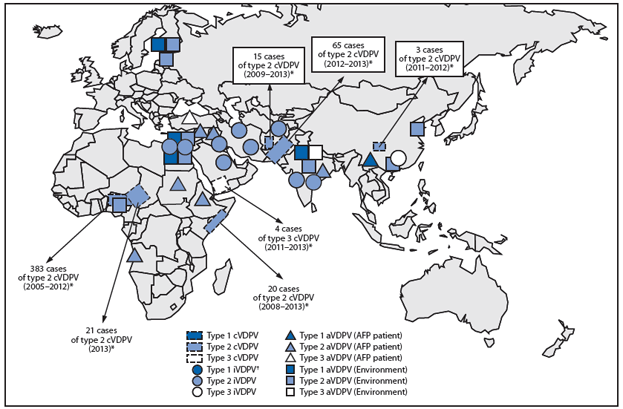Polio, a highly infectious disease caused by the poliovirus, has been a significant public health concern for decades. Despite the significant progress made in eradicating the disease through widespread vaccination efforts, a new challenge has emerged in the form of Circulating Vaccine-Derived Poliovirus (cVDPV). In 2025, the World Health Organization (WHO) has reported an alarming increase in cVDPV cases, posing a threat to the global efforts to eradicate polio.

What is cVDPV?
cVDPV is a strain of poliovirus that emerges from the vaccine itself. The oral poliovirus vaccine (OPV) contains a weakened form of the virus, which is intended to replicate in the gut and provide immunity to the recipient. However, in rare cases, the weakened virus can mutate and regain its virulence, leading to the emergence of cVDPV. This mutated virus can then spread to other individuals, causing polio-like illnesses.
How does cVDPV spread?
cVDPV can spread through the fecal-oral route, where the virus is shed in the feces of an infected person and ingested by another person through contaminated food, water, or hands. The virus can also spread through person-to-person contact, particularly in areas with poor sanitation and hygiene.
Symptoms of cVDPV
The symptoms of cVDPV are similar to those of wild poliovirus, including:
- Fever
- Headache
- Stiff neck
- Muscle weakness
- Sore throat
- Vomiting
- Diarrhea
In severe cases, cVDPV can cause paralysis, respiratory failure, and even death.
Global Response to cVDPV
The WHO, along with other global health partners, has launched a comprehensive response to address the growing concern of cVDPV. The response includes:
- Enhanced surveillance: Improving surveillance and monitoring systems to detect and respond to cVDPV outbreaks quickly.
- Vaccination campaigns: Conducting targeted vaccination campaigns using the inactivated poliovirus vaccine (IPV) or OPV to boost immunity in high-risk areas.
- Sanitation and hygiene improvements: Implementing sanitation and hygiene improvements, such as improved waste management and handwashing practices, to reduce the spread of cVDPV.
- Community engagement: Engaging with local communities to raise awareness about cVDPV and promote vaccination uptake.
Challenges in Addressing cVDPV
Despite the global response, addressing cVDPV poses several challenges, including:
- Limited access to healthcare: In many areas, particularly in conflict-affected or remote regions, access to healthcare and vaccination services is limited, making it difficult to detect and respond to cVDPV outbreaks.
- Vaccine hesitancy: Vaccine hesitancy and misinformation can lead to reduced vaccination uptake, creating a fertile ground for cVDPV to spread.
- Funding constraints: The response to cVDPV requires significant funding, which can be a challenge, particularly in low- and middle-income countries.
FAQs
- What is the difference between wild poliovirus and cVDPV?
Wild poliovirus is the naturally occurring virus, while cVDPV is a mutated strain that emerges from the vaccine. - Is cVDPV contagious?
Yes, cVDPV can spread from person to person through the fecal-oral route or through contaminated food and water. - Can cVDPV be treated?
There is no specific treatment for cVDPV, but symptoms can be managed with medical care. - How can I protect myself from cVDPV?
Get vaccinated, practice good hygiene, and ensure proper sanitation and waste management. - Is cVDPV a concern for travelers?
Yes, cVDPV can be a concern for travelers, particularly those traveling to areas with ongoing outbreaks.
Conclusion
Circulating Vaccine-Derived Poliovirus (cVDPV) is a growing concern in 2025, posing a significant threat to global efforts to eradicate polio. The WHO and other global health partners are working tirelessly to respond to cVDPV outbreaks, but challenges remain, including limited access to healthcare, vaccine hesitancy, and funding constraints. It is essential for governments, healthcare workers, and communities to work together to raise awareness, improve vaccination uptake, and implement sanitation and hygiene improvements to prevent the spread of cVDPV. By doing so, we can ensure that the progress made in eradicating polio is not reversed and that we can finally achieve a polio-free world.
Recommendations
- Get vaccinated: Ensure that you and your family members are up-to-date on polio vaccinations.
- Practice good hygiene: Wash your hands frequently, especially after using the bathroom and before eating.
- Support global health efforts: Donate to reputable organizations working to eradicate polio and support global health initiatives.
- Stay informed: Stay up-to-date on cVDPV outbreaks and response efforts through reliable sources, such as the WHO and CDC.
By working together, we can overcome the challenges posed by cVDPV and achieve a polio-free world.
Closure
Thus, we hope this article has provided valuable insights into Circulating Vaccine-Derived Poliovirus (cVDPV): A Growing Concern in 2025. We hope you find this article informative and beneficial. See you in our next article!